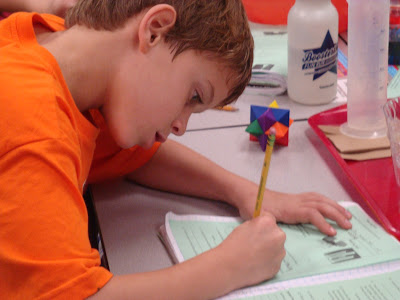To get started, students had to make a hypothesis about which has more mass a crayon or a pencil. Then, using a pan balance with gram weights, they had to measure the mass of each.
After that, they made a hypothesis on whether a marble or a seashell had more mass, and then measured the mass of each. (When the groups analyze their data, they will realize that the mass of all the marbles in the class are the same, however the mass of the seashell changes. The smaller the seashell the less the mass, the bigger the seashell, the larger the mass.)
Furthermore, students made a prediction about the volume of two cups of liquid, and then used a graduated cylinder to measure each volume. (The red liquid was in a tall narrow glass and the blue liquid was in a small wide glass. Each contained 150 mL of colored water.)
Students were surprised to discover that they could also find the volume of a solid. An object's volume is the amount of space the object takes up. To find the volume of a solid, like the marble and the seashell, students used water displacement. They put 100 mL of water in a graduated cylinder, then gently dropped the solid in the water. The volume is recorded by the number of mL of water that was displaced, or moved.
Tomorrow, we will have Closing Session where students will have to compare and then explain their results. By the end of Science Workshop tomorrow, students will be able to tell how the mass of matter is measured, and how the volume of a solid and liquid is measured.








1 comment:
Great lab with such fantastic photographs!
Post a Comment